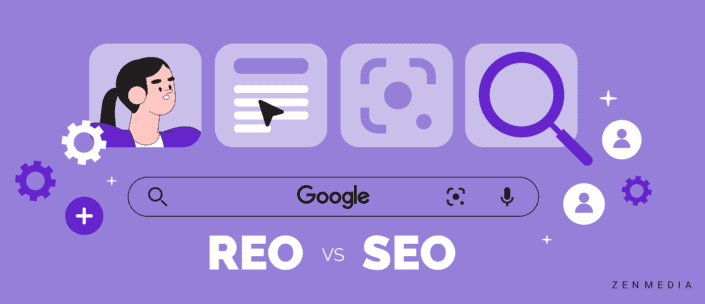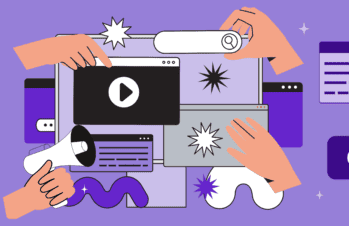We know, we know. Another trendy marketing term and another change to the way we search. As marketers, we should be used to these constant changes. Still, it can feel overwhelming trying to keep up with every new acronym and SEO strategy that comes our way.
Recommendation Engine Optimization—or REO—is SEO for our current and future digital landscape. Why? Because REO not only builds on SEO, it factors AI and other emerging technologies into the conversation.
Why should you pay attention to REO? Unlike the SEO techniques we already know and love, REO’s emphasis on expanding search to mimic the actual user experience makes it worth learning about.
And REO doesn’t just show us what search engine optimization will look like in 2024. It gives us a glimpse into how the industry will continue to adapt content to meet the constant evolutions of search engine algorithms, accommodate organic search, and influence content marketing.
While SEO has held its ground as the cornerstone of digital marketing trends since its inception, the emergence of recommendation engines presents a new frontier for brands to explore. And as a B2B, you need both SEO and REO to maximize your online presence and effectively reach your target audience.
So, where do you start? The first step is understanding REO and how it compares to SEO. Then, you’ll need to dissect each tool’s strengths and key differences before exploring the best ways to add REO to your marketing strategy.
Why Should You Pay Attention to REO?
If there’s one thing we can be sure of, it’s that search engines aren’t going anywhere. In fact, they will continue to evolve to meet our needs.
That said, search engines are no longer the gateways to information they used to be. Instead, they’re a subset of greater discovery on the internet, and REO is a broader umbrella term with specific types of optimizations and channels below it, bringing together all recommended information destinations.
The scale and speed at which we are using these discovery tools is changing and as marketers, it’s our job to find ways to optimize that behavior.
What is SEO?
Search engine optimization is the bread and butter of digital marketing. It encompasses a seemingly endless amount of strategies to improve and enhance your brand’s search engine rankings based on user behaviors.
SEO tools use search intent to help marketers find and use relevant keywords to build high-quality content that drives organic search traffic to a brand’s site. Two types of SEO include on-page and off-page SEO, and apply to every industry and form of media.
On-page SEO focuses on your website and reviews long-tail keywords, internal linking, and external links in blogs or other written content. Load times are also relevant for on-page SEO, determining website and mobile optimization.
For off-page SEO, brands must consider user intent to guide link building and drive traffic from search engines to their sites. This includes conducting a competitor analysis, implementing backlinks, and increasing brand awareness and engagement on social media.
This technical optimization informs content creation and overall SEO marketing strategy, using different avenues that can be modified for any campaign, brand, or industry.
Why is SEO Still Important?
SEO remains a vital tool for improving website visibility and ranking on search engine results pages (SERPs). REO takes that a few steps further, leveraging user data and machine learning algorithms to personalize content delivery, enhancing user engagement and driving conversions.
Where search engines used to be the starting point for all online research, the growth of social media, apps, and AI means search engines are now just one more portal to access information. REO takes the reins by delivering information that makes sense for our modern technology usage behaviors.
Understanding The Ways we Search
Before, if we were looking for a specific restaurant, we would search its name in Google or another browser to access their website and contact information.
Nowadays, that research begins much sooner. At first, you might see a photo from the restaurant on Instagram, and then be served a Google ad for the restaurant when you’re browsing the internet. By the time you’re ready to try it out and look up the hours, address, and menu, the search engine is no longer your primary source of information. Instead, it supplements everything else you’ve already learned about that restaurant.
And sometimes you’ll bypass the search engine entirely, looking up the business on your social media apps instead. This era of user-generated content and sharing in untraceable ways is what caused SEO to change.
Marketing across industries works in the same way now. We’re recommending brands, products, and services in our DMs, during meetings, via texts, in emails, and across social media platforms. But this isn’t new. Word of mouth has been a critical part of business as long as marketing has been around. The difference? We have more untraceable avenues to share information than ever before. This is dark social and it should be on your radar.
Dark Social and REO
The convergence of dark social and REO happens when you keep hearing about the same brand, product, or service in small, private conversations. This is frustrating for marketers because we can’t track what’s being said, where, and by whom. Instead, we have to trust that these avenues will lead prospects our way and must account for them in our marketing strategies.
Consider Gen Z, the generation expected to overtake Baby Boomers in the workforce this year. This generational shift will bring new trends and behaviors to monitor across marketing and the B2B landscape. For example, millennials spearheaded the era of user-generated content, sharing everything publicly online. Gen Z, on the other hand, by and large has chosen to consume publicly and share privately.
And look at some of the top social media platforms.
We already know that TikTok is popular with Gen Z, but what do we know about other channels? With 35% of Gen Zers on Discord, marketers must also identify how to influence and reach audiences there. How can we do this when most Discord users prefer to interact in private chats and groups?
Even on LinkedIn, how many people are privately messaging authors instead of commenting on their posts or sharing the posts with their colleagues in Slack? With so much happening in dark social spaces, is it even possible to reach users through marketing?
In short, yes. Digital marketing has been a constant case study in adaptability. The internet was initially a novelty with some viral videos and skeletal websites that quickly grew into an information superpower. Millennial usage of the internet sparked keyword stuffing and the first iteration of SEO. Then came the revamped version where brands realized users cared about consuming meaningful content. Now, we understand that we can’t just rely on one channel. We feel the need to be everywhere at once.
Through this increased awareness, brands are better primed to make it into these private spaces and drive conversions.
Evolving the Digital Searchscape
Discord is also a great case study in embracing the myriad tools aiding search engines. You can use text, voice, and chat within the platform. Alexa and Siri popularized asking questions out loud and Google gave us image search capabilities. ChatGPT and generative AI are still new, but they’re already changing the way we search.
Digital marketers have taken digital transformation head on, modifying their approaches to search rankings, keyword phrases, and content optimization. Beyond online search, digital marketers have focused on adding helpful content to various forms of media.
For social media marketing, this meant guest posting, linking relevant content, tagging brands, engaging with communities, hosting livestreams, and sharing or posting user-generated content. YouTube ads started to incorporate QR codes to make it easier for consumers to visit sites, blog posts included internal links to keep us on a brand’s site, and commercials started to directly address our Alexa devices.
As channel fragmentation increases and technology continues to evolve, users will be able to conduct more research in more places with greater refinement to suit their incredibly precise needs. Filtering and customizing search engines at this scale increases the overall cost of user acquisition and when it takes 27-32 touchpoints to convert a prospect to a buyer, the numbers start to add up.
So what can B2B companies do to embrace these changes? A good first step is to learn about each of the four major search channels and how to leverage their use.
Traditional Search Engines
Google leads search engine marketing with tools that include Google Analytics, smart search algorithms, keyword ranking, and general search visibility. It also brings in the largest global search volume; more than 91% of searchers use Google search, eclipsing every other search engine combined. Understandably, Google is the go-to digital marketing strategy resource for organizations.
Naturally, it makes sense that the search engine that started it all has also continued evolving its technology and capabilities. For example, Google recently introduced three changes. They eliminated pages, their desktop searches now include tabs called Perspectives, and changes to the algorithms mean marketers should work on prioritizing the E-E-A-T relevance of their content. E-E-A-T stands for Experience, Expertise, Authoritativeness, and Trustworthiness; it’s the framework used by Google to assess the quality of content on websites.
Rented Channel Optimization
Social media can quickly turn into an endless deep dive into the searchscape. We’ve all been there, right? You visit one profile, which leads you to another, then another, and then you start searching for something else, and so on until you’ve spent 30 minutes hopping from page to page, forgetting what you were looking for in the first place.
That said, it’s also a great place to search collectively, adding a community element to the channel. Let’s look at TikTok again. Whether seeking fashion advice, new recipes, health tips, or entertainment recommendations, TikTok has emerged as a major search engine and source for driving organic traffic. In fact, Adobe found that 64% of Gen Zers and 49% of millennials have used TikTok as a search engine, with 1 in 10 Gen Z users preferring the app to Google.
But this behavior isn’t isolated to the younger generations. Broadly, 41% of consumers have reportedly used TikTok as a search engine. TikTok’s response? Adding search bars with recommended topics directly into its content.
This search option appears at the top or bottom of a video and within a video’s comment section. The genius part? Rather than taking you out of the app to a relevant article or website, TikTok’s search tool redirects you to their large library of content that matches the topic you searched. Now marketers must pivot away from solely relying on hashtags and clever captions to adding as many keywords as possible to make their content discoverable within the app.
When an app designed to keep you viewing, sharing, and creating content finds even more ways to keep you engaged and scrolling, it’s done its job.
PR and Earned Media
We all know the value, trust, and credibility we gain from doing PR, but now even earned media is informing generative AI results. This is because AI takes information it’s fed, so the more information available about a brand from any source, the more likely it is to end up as a search result in ChatGPT.
This also plays a major role in Google’s SEO ranking guided by the E-E-A-T model. From podcast appearances to bylined articles and other forms of organic promotion, B2B companies are wise to add earned media as another channel to drive search results. .
Emerging Media
Another pro tip for improving your brand’s E-E-A-T? Focusing on the content you publish (owned media). This includes auditing your website and creating multi-channel content to amplify your message. This might also mean investing in emerging technologies.
Voice search, OpenAI and ChatGPT, Discord, TikTok, and dark social. These are the avenues we have to pay attention to as marketers as we look beyond traditional search engines to plan effective digital strategies. Spend time navigating these channels and learning about the ways people are using them to search, then build content around them to support those behaviors.
If you’ll benefit from a Discord server, start one! If how-to videos on TikTok will drive more traffic to your site, start filming and editing! Not sure how to draft a script or build a blog outline? Ask ChatGPT. Don’t be intimidated by these new tools. Instead, experiment when it makes sense and move on when it doesn’t.
When combined, REO and SEO shape the patterns marketers use in audience targeting, content strategy, and overall marketing efficacy. Understanding the nuances of REO and SEO is paramount to crafting a robust online presence.
Integrating these strategies not only enables us to navigate the constant changes happening in the search world, it can bring harmony to comprehensive digital marketing frameworks and unlock the full potential of digital marketing in the modern age.







